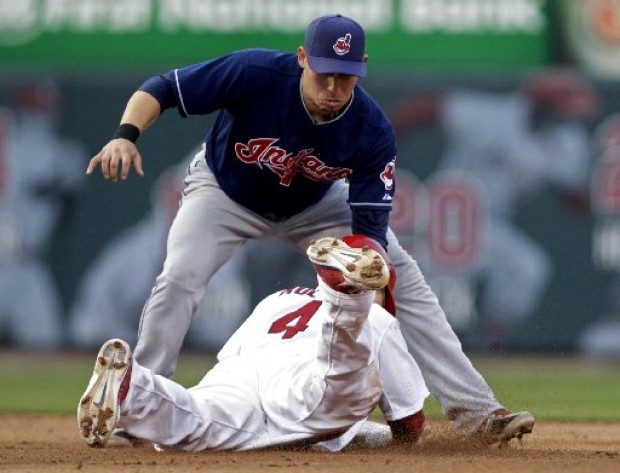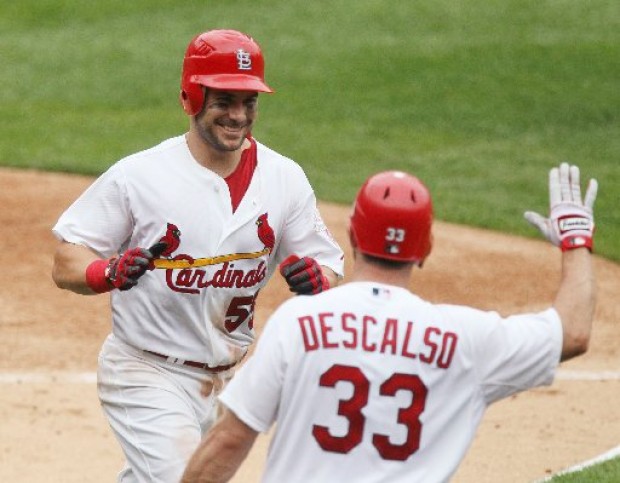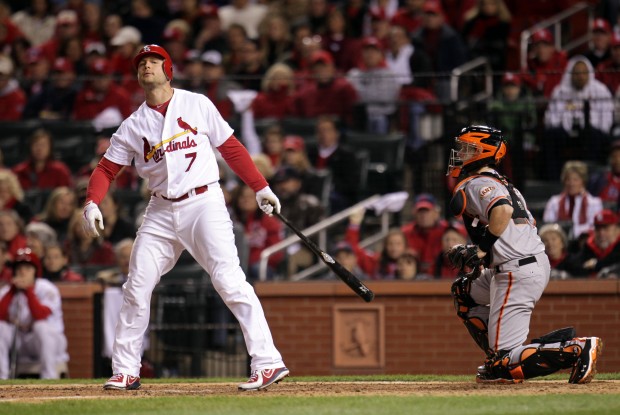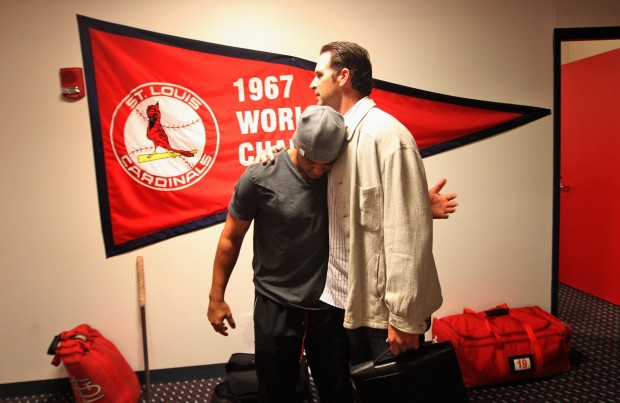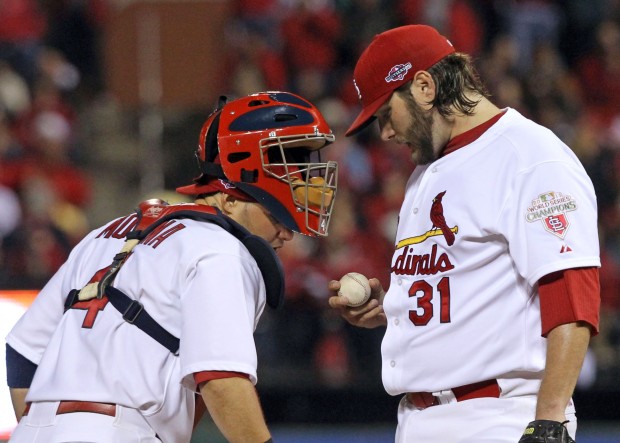Cardinals general manager John Mozeliak made an immediate
move Tuesday to start clearing roster space on the same day he received
news that could influence future moves.
The Cardinals gave reliever Kyle McClellan, the longest-tenured member of the bullpen, his unconditional release, sending the righty into free agency even as he tries to rehab from an arm injury.
Two other Cardinals recovering from arm injuries, pitcher Jaime Garcia and shortstop Rafael Furcal, have made encouraging progress, Mozeliak said after receiving reports from his medical staff. Garcia threw off the mound Monday and Furcal will have his elbow re-evaluated this weekend as part of his rehab.
It’s the improvement from Furcal that could modify Mozeliak’s winter wish list.
“Knowing that the two players we’re talking about have had positive outcomes in (their rehabs) provides optimism,” Mozeliak said. “It’s something you consider in your offseason strategy. It does mean we don’t have to chase a shortstop at this point.”
Garcia was placed on the disabled list during the postseason with a tear in his rotator cuff and inflammation inside his shoulder. A tour of specialists commenced, and though surgery was one recommendation for the lefty, after a consultation with Dr. James Andrews, he pursued a treatment program to avoid a procedure.
On Monday at Busch Stadium, Garcia threw about 25 pitches off the mound. He will continue physical therapy this month and by December begin a “normal offseason,” Mozeliak said.
The current plan is to have him on the preparation regimen in January, though the Cardinals have said the success of Garcia’s recovery won’t be clear until he pitches during spring training. Garcia has acknowledged that his hope to avoid surgery means sticking to exercises and treatment.
Furcal, likewise, sought to avoid surgery to repair a tear in his elbow.
Such a procedure would push back his availability for 2013 and enhance the Cardinals’ need to explore the shortstop market this winter. Furcal’s health would change the Cardinals’ urgency, but the club acknowledges a need to at least explore depth options in the middle infield.
Furcal is scheduled to return from the Dominican Republic this weekend, and he’ll meet with members of the medical staff in Florida to have his elbow re-evaluated. The shortstop’s agent said Furcal has not yet attempted baseball activities such as throwing. Paul Kinzer said his client is “very confident he’ll be ready at the start of the year.”
Mozeliak said during his conversations with trainers Tuesday “the word surgery never came up” for either Furcal or Garcia.
McClellan has a similar spring training target in mind, though for the first time in his career he no longer knows the team he’ll be on. The St. Louis-area native missed more four than months of the season and needed surgery to repair damage in his right shoulder. He is in the middle of a throwing program to strengthen his arm and will visit with the surgeon in early December. He said he expects to be ready for spring training.
McClellan would be eligible for arbitration this winter, and the Cardinals chose to release him Tuesday rather than to not offer him a contract by the deadline later this month. The release allows him to become a free agent a few weeks before other arbitration-eligible players are not tendered offers on or before Nov. 30.
It also frees up a spot on the 40-man roster for the team to use before next Tuesday’s deadline to protect players from the Rule 5 draft. The Cardinals have four open spots on the roster and another move in the coming week is likely as the team clears room for minor-leaguers such as lefty Kevin Siegrist and righty Eric Fornataro.
“When you look at the situation from my standpoint you see that they have a lot of young, exciting arms coming up and they’re excited about that and have every reason to be,” said McClellan, a Hazelwood West grad. “They have guys ready to contribute at the major-league level. They want to see them get that chance. And you can see how it makes sense for both sides to explore other opportunities.”
McClellan was the Cardinals’ 25th-round pick in 2002, and he jumped from Class AA to the major-league bullpen to open 2008 with the team. In 261 appearances over five seasons, McClellan was 19-23 with a 3.69 ERA. The Cardinals’ depth at his role made Tuesday’s release possible for the tenured reliever.
He’s not alone in feeling that squeeze. Skip Schumaker, one of only two position players remaining from the Cardinals’ 2006 club, is in a similar depth-pinch as the Cardinals look to others at second base and in utility roles. Sources have described the club as willing to trade Schumaker, who has a year remaining on his contract.
McClellan, 28, was told of his release Tuesday morning. He said he didn’t want to get his “hopes up or down” for what offers he’ll find as a free agent. He recognizes he’ll have to prove his health and that he may not go to spring training with a guaranteed roster spot.
“Either way I’ll have to have a good spring training,” McClellan said. “I have to prove my health. You’d love to have the security of a major-league deal. As long as I’m healthy, I’m confident in my ability and what I can do when given an opportunity.”
The Cardinals signed catcher Rob Johnson to a minor-league contract that came with an invitation to major-league spring training. Johnson, 30, will offer depth behind backup Tony Cruz. The Montana native was with the Mets and their Class AAA affiliate in 2012.
The Cardinals gave reliever Kyle McClellan, the longest-tenured member of the bullpen, his unconditional release, sending the righty into free agency even as he tries to rehab from an arm injury.
Two other Cardinals recovering from arm injuries, pitcher Jaime Garcia and shortstop Rafael Furcal, have made encouraging progress, Mozeliak said after receiving reports from his medical staff. Garcia threw off the mound Monday and Furcal will have his elbow re-evaluated this weekend as part of his rehab.
It’s the improvement from Furcal that could modify Mozeliak’s winter wish list.
“Knowing that the two players we’re talking about have had positive outcomes in (their rehabs) provides optimism,” Mozeliak said. “It’s something you consider in your offseason strategy. It does mean we don’t have to chase a shortstop at this point.”
Garcia was placed on the disabled list during the postseason with a tear in his rotator cuff and inflammation inside his shoulder. A tour of specialists commenced, and though surgery was one recommendation for the lefty, after a consultation with Dr. James Andrews, he pursued a treatment program to avoid a procedure.
On Monday at Busch Stadium, Garcia threw about 25 pitches off the mound. He will continue physical therapy this month and by December begin a “normal offseason,” Mozeliak said.
The current plan is to have him on the preparation regimen in January, though the Cardinals have said the success of Garcia’s recovery won’t be clear until he pitches during spring training. Garcia has acknowledged that his hope to avoid surgery means sticking to exercises and treatment.
Furcal, likewise, sought to avoid surgery to repair a tear in his elbow.
Such a procedure would push back his availability for 2013 and enhance the Cardinals’ need to explore the shortstop market this winter. Furcal’s health would change the Cardinals’ urgency, but the club acknowledges a need to at least explore depth options in the middle infield.
Furcal is scheduled to return from the Dominican Republic this weekend, and he’ll meet with members of the medical staff in Florida to have his elbow re-evaluated. The shortstop’s agent said Furcal has not yet attempted baseball activities such as throwing. Paul Kinzer said his client is “very confident he’ll be ready at the start of the year.”
Mozeliak said during his conversations with trainers Tuesday “the word surgery never came up” for either Furcal or Garcia.
McClellan has a similar spring training target in mind, though for the first time in his career he no longer knows the team he’ll be on. The St. Louis-area native missed more four than months of the season and needed surgery to repair damage in his right shoulder. He is in the middle of a throwing program to strengthen his arm and will visit with the surgeon in early December. He said he expects to be ready for spring training.
McClellan would be eligible for arbitration this winter, and the Cardinals chose to release him Tuesday rather than to not offer him a contract by the deadline later this month. The release allows him to become a free agent a few weeks before other arbitration-eligible players are not tendered offers on or before Nov. 30.
It also frees up a spot on the 40-man roster for the team to use before next Tuesday’s deadline to protect players from the Rule 5 draft. The Cardinals have four open spots on the roster and another move in the coming week is likely as the team clears room for minor-leaguers such as lefty Kevin Siegrist and righty Eric Fornataro.
“When you look at the situation from my standpoint you see that they have a lot of young, exciting arms coming up and they’re excited about that and have every reason to be,” said McClellan, a Hazelwood West grad. “They have guys ready to contribute at the major-league level. They want to see them get that chance. And you can see how it makes sense for both sides to explore other opportunities.”
McClellan was the Cardinals’ 25th-round pick in 2002, and he jumped from Class AA to the major-league bullpen to open 2008 with the team. In 261 appearances over five seasons, McClellan was 19-23 with a 3.69 ERA. The Cardinals’ depth at his role made Tuesday’s release possible for the tenured reliever.
He’s not alone in feeling that squeeze. Skip Schumaker, one of only two position players remaining from the Cardinals’ 2006 club, is in a similar depth-pinch as the Cardinals look to others at second base and in utility roles. Sources have described the club as willing to trade Schumaker, who has a year remaining on his contract.
McClellan, 28, was told of his release Tuesday morning. He said he didn’t want to get his “hopes up or down” for what offers he’ll find as a free agent. He recognizes he’ll have to prove his health and that he may not go to spring training with a guaranteed roster spot.
“Either way I’ll have to have a good spring training,” McClellan said. “I have to prove my health. You’d love to have the security of a major-league deal. As long as I’m healthy, I’m confident in my ability and what I can do when given an opportunity.”
The Cardinals signed catcher Rob Johnson to a minor-league contract that came with an invitation to major-league spring training. Johnson, 30, will offer depth behind backup Tony Cruz. The Montana native was with the Mets and their Class AAA affiliate in 2012.

